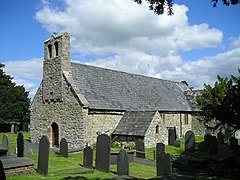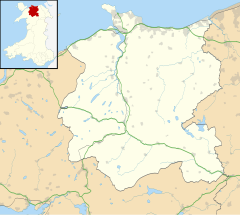Caerhun
Caerhun
|
|
|---|---|
 St Mary's Church |
|
| Caerhun shown within Conwy | |
| Population | 1,292 (2011) |
| OS grid reference | SH774704 |
| Community |
|
| Principal area | |
| Ceremonial county | |
| Country | Wales |
| Sovereign state | United Kingdom |
| Post town | CONWY |
| Postcode district | LL32 |
| Dialling code | 01492 |
| Police | North Wales |
| Fire | North Wales |
| Ambulance | Welsh |
| EU Parliament | Wales |
| UK Parliament | |
| Welsh Assembly | |
Caerhun (Welsh: Caerhûn) is a scattered rural community, and former civil parish, on the west bank of the River Conwy. It lies to the south of Henryd and the north of Dolgarrog, in Conwy County Borough, Wales, and includes the villages of Llanbedr-y-cennin, Rowen, Tal-y-bont and Ty'n-y-groes. At the 2001 census, it had a population of 1,200, increasing to 1,292 at the 2011 census.
Surrounding the 14th-century parish church of St. Mary are the banks of the Roman fort of Canovium. The excavations of the Roman site were directed by P.K. Baillie Reynolds, of Aberystwyth University, over a period of four summers in the 1920s, although there have of course been several other publications since.
The church and its churchyard occupy the north-east quarter of the original Roman site. Canovium was built at an ancient river crossing and was an important post on the Roman road and ancient drovers road via Bwlch-y-Ddeufaen to Abergwyngregyn and the Menai Strait. Latterly the best crossing point, now with a bridge, has been at nearby Tal-y-Cafn. After the end of Roman rule in Britain, the fort was associated with King Rhun Hir of Gwynedd, hence the subsequent name.
...
Wikipedia

